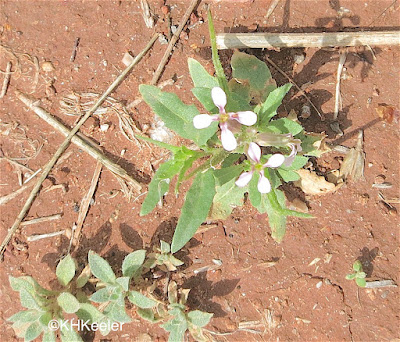 |
| blue mustard, Chorispora tenella |
There are eleven species in the genus Chorispora, native to Europe, Asia, and north Africa. Only blue mustard, C. tenella, has made it to North America. Blue mustard is found all across the western U.S. and very occassionally in the eastern half of the U.S. (see map); so depending on where you live it is very familiar or unknown to you. However, articles on its distribution suggested it has rather recently (last half of 20th century) spread, into the interior of Montana, to norothern Ohio, etc. Sometimes that means the plant just arrived, but it can also mean that it took some decades or even a century of being a rare exotic before it had sufficient numbers to spread its seeds widely. So, perhaps, if you don't know it, you live in a place where it will show up soon.
 |
| blue mustard in a grassy field |
The scientific name is descriptive. Chori in Chorispora means "separate" in Latin, while spora is "seed." The combination, "separate seed," refers to the distinctive way the long narrow fruit breaks apart into units of one seed only (see fruit: link). It is much more common for a mustard seed pod to split along the sides, dropping all the seeds out, so pinching off individual seeds was a character the namer of Chorispora thought important. (Lots of mustards are identified by their fruits.) The species epithet, tenella, means delicate, a nice description.
For me in northern Colorado, the flower is imporant to identifying blue mustard. Most weedy mustards have yellow or white flowers. Where I live, there are no other delicate blue-flowered mustards. However, blue mustard's flowers look purple in some places and to some people, and rather pink in my photos, so it is not so much the exact color but that it isn't white or yellow. Purple mustard is an alternate common name. (Most places have at least one other weedy European non-white/non-yellow mustard, so don't rely solely on flower color to recognize blue mustard, check what your local choices are, then compare seed pot shape, "delicacy," hairiness of leaves.)
The USDA Plants database gives crossflower as the common name for this plant. That seems like a poor choice to me, since flowers shaped like crosses are characteristic of its entire plant family, the mustards. There are some 3,973 species, many very widespread in the Northern Hemisphere, almost all with cross-shaped flowers. (In some plant families, flower shape varies a lot). A spring walk will easily encounter five or six different species of mustards with cross-shaped flowers. Calling it blue crossflower would make sense to me, but just crossflower--strange. But a traditional common name is traditional, not necessarily logical.
Blue mustard has a distinctive smell, so it is also called musk mustard. I haven't noticed the scent, but I haven't hiked off trail in a dense stand of blue mustard or had my dog come back from romping in it. The smell is generally described as unpleasant, similar to a stale dish rag.
 |
| Dense patch of blue mustard |
It can be a problem weed. When abundant, it reduces crop production, for example, of winter wheat. The milk of cows that eat it can have an off taste in their milk, making a problem for dairy farmers. Its abundant seeds contaminate commercial grass seed production. Since it is an annual, cutting off flowers before seeds mature is an effective means of control, though if the patch is well-established, buried seeds are likely to sprout for some years.
Interactions with animals are not much reported. Many pierid butterflies lay their eggs on mustards, but only one, the western white (Pontia occidentalis, photos), is reported to use blue mustard. I think that merely means no one has studied it, since the database I checked is worldwide (hosts.nhm.ac.uk, there should be multiple insects that eat it in its native range). Similarly, wild animals must eat it--leaves or seeds--but not much has been printed.
People eat it. The plant is edible and the leaves are a popular wild green. See the blog Awkward Botany for discussion and a lovely photo of a sandwich with blue mustard. Curiously, not one of my foraging books, including the western ones, mentions it, which reinforces the idea that its spread is recent, since online sites speak highly of it (another example link).
An interesting, tasty blue-purple mustard to watch for.
Comments and corrections welcome.
References
Al-Shahbaz. 2010. 48. Chorispora R. Brown ex de Candolle. Flora of North America. link Accessed 5/15/20.
Awkward Botany 2019. Eating Weeds: Blue Mustard link Accessed 5/14/20.
Clotfelter, S. 2012. Wild File Flora: Blue Mustard, a familiar scent in Colorado. The Denver Post. April 20, 2012. Accessed 5/10/20.
Whitson, T. D. editor. 1992. Weeds of the West. Western Society of Weed Science, Newark, CA.
Zachos, Ellen. 2017. Musk Mustard Backyard Forager link Accessed 5/17/20.


Thanks for your post - I adore the smell of blue mustard. It's one of my favorite parts of spring. To me it smells a little like crayons.
ReplyDelete